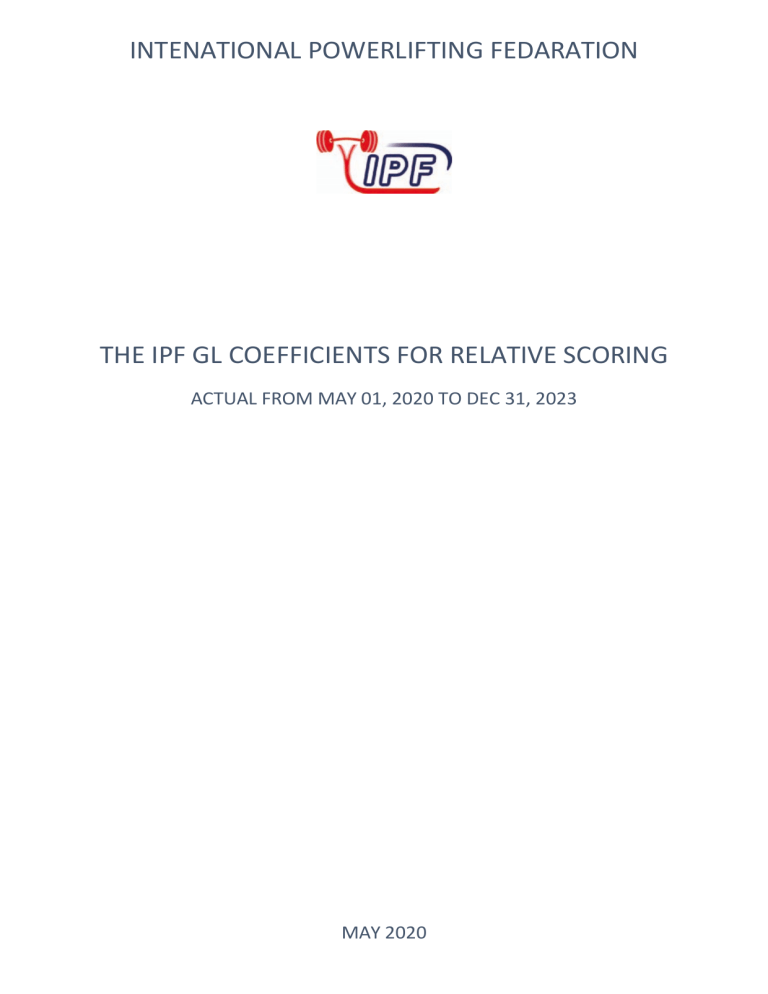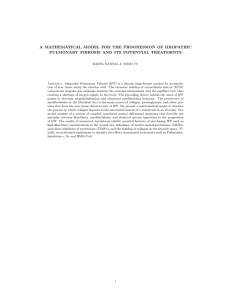
INTENATIONAL POWERLIFTING FEDARATION THE IPF GL COEFFICIENTS FOR RELATIVE SCORING ACTUAL FROM MAY 01, 2020 TO DEC 31, 2023 MAY 2020 1 Key Points In powerlifting, differences in the size of the athlete’s body, and therefore in their body weight, are reflected in the divide of powerlifters into different weight classes. However, in certain cases, it is necessary to determine who is the best athlete in the competition or what is the best result that has ever been achieved in many competitions, without taking into account differences in body weight. Thus, we are talking about a system for assessing the achievement of athletes in relation to their body weight – or, in other words, a relative evaluation. Any evaluation system has the goal of converting the objective result shown by the athlete (in our case, expressed in an objective measure: kilograms) into some conventional points. The rule for converting a sports result into points is called a scoring scale. From a practical point of view, a scoring scale given in the form of a formula was used, namely: (1) The equalization coefficient is calculated by the formula: ⋅ (2) ⋅ where Bwt – body weight; A, B, C – constants; e is the base of the natural logarithm; 100 – normalization factor and body weight for men and for women. The parameters of the equation (constants) for various types of competitions are given in Table 1. Women’ s Men’ s Table 1. The parameters of the equation Equipped Powerlifting A 1236.25115 B 1449.21864 C 0.01644 Classic Powerlifting 1199.72839 1025.18162 0.00921 Equipped Bench Press 381.22073 733.79378 0.02398 Classic Bench Press 320.98041 281.40258 0.01008 Equipped Powerlifting 758.63878 949.31382 0.02435 Classic Powerlifting 610.32796 1045.59282 0.03048 Equipped Bench Press 221.82209 357.00377 0.02937 Classic Bench Press 142.40398 442.52671 0.04724 2 Brief comments on the formula IPF GL coefficients are derived statistically. They are based on a statistical evaluation by methods of regression analysis of the results of the elite athletes’ samples (Golden Standard Samples) of various weight classes and in various types of powerlifting programs. The Golden Standard Samples contain no more than one best result for athletes whose achievement is not less than 16% of the current world records in the respective weight classes. The samples included achievements shown at official IPF international and European competitions, as well as official world and European records, starting in 2011. The equivalent levels of strength performance of elite athletes are determined based on the analysis of the subject area from the point of view of sports science and biology. The type of regression function was derived on the basis of the following assumptions: 1) With increasing body weight, the absolute result increases, and the relative performance (as the ratio of the result to the weight of one’s own body) decreases. Thus, an increase in body weight leads to an improvement in the absolute result. This dependence can be represented as a strictly monotonically increasing function. 2) At the same time, the relative result decreases (the relative result means the simple ratio of the result to the athlete’s body weight at which this result was obtained). This indicates the existence of some reasons that oppose the process of a linear increase in the result. And this conclusion narrows the search for the functional dependence of regression to the choice of the balance equation, expressed, in our case, by the energy conservation law. Such balance equations have been widely used in biology in the framework of growth theory for more than a hundred years. 3) Due to objective physical limitations (and, first of all, gravitational ones), there is a potential physical limit for the result both for each value of body weight and the absolute weight limit for the entire population. This allows us to state that the sought function should have an upper asymptotic limit. Thus, it can be assumed that the rate of growth of strength performance with increasing body weight is determined by the difference in the specific productivity and specific losses that are limiting for this weight, which are a consequence of the necessary energy expenditures of the body associated with increased body weight. This statement can be expressed using the differential equation , where P – strength performance, Bwt – body weight, PM – maximum possible specific performance (productivity per weight unit), PL – specific performance losses. The solution to this equation is the equation 3 ∙ This equation expresses the logical relationship between relative strength performance and body weight of athletes. In the final form, the equalization coefficient is calculated by the formula: ∙ where Bwt – body weight, A, B, C – constants and e is the base of the natural logarithm, 100 – normalization factor. From a substantive point of view, the formula answers the question, “What is the level of strength performance of an athlete in relation to the level of performance of an elite athlete of the same body weight?”. Since equivalent productivity levels of an elite athlete are determined for each possible body weight, this makes it possible to compare the achievements of athletes with different body weights. The value of the normalization factor 100 was not chosen randomly. In fact, this value makes it possible to interpret relative points as a percentage of strength productivity in relation to the reference performance of elite lifters for a given body weight. The performance golden standard (average elite athlete's level) for each body weight is set equal to 100 points. Statistical analysis showed that factors important for the competitive powerlifting program, such as gender of athletes, use of equipment, and type of exercise, are significant factors that greatly affect the result. Therefore, for a more accurate reflection of the laws of the dependence “body weight – performance”, the coefficients are determined for all combinations of competitions that are officially used in the IPF. The relevant parameters for the equation are shown in Table 1. An analysis of the stability of the obtained equations to new data by cross-validation methods showed that there is significant stability; however, it was found that the parameters are subject to change over time. Therefore, in order to most closely match the current terms of the competition, the coefficients require periodic adjustment. It is reasonable to adopt a four-year cycle during the adjustment period, and it is advisable to recount the parameters one year before the World Games year (selection and preparation for the largest four-year competitions by analogy with the Olympic cycle). The IPF abbreviation in the name of the coefficient reflects the fact that the formula is developed on the basis of processing the results of official competitions of the International Powerlifting Federation; adapted to the competition terms and IPF rules; officially recognized and used by IPF. The GL abbreviation was introduced to distinguish it from the previous IPF formula, which was used in 2019, and also reflects the fact that the formula was proposed by the team of developers of the GOODLIFT information system, the official scoring system used by IPF. In official documents, the formula is referred to as IPF GL Formula; equalization coefficient – as IPF GL Coefficient; relative performance rating points – as IPF GL Points. In print and electronic score sheets, the GLP (glp) designation is allowed to save space. 4 One of the requirements for rating scales is: “Sensitivity” of the formula should correspond to the accuracy of measuring the result. This means that either the smallest change in the result should be reflected, in our case, the change in the result from 0.5kg, or the smallest possible change in body weight specified by the rules – 0.01kg. Thus, the coefficients should also be different for each different value of body weight. From this point of view, the computational accuracy of the coefficients was chosen – up to 6 decimal places. In order to unify the calculation of relative points, the following procedure is introduced: equalization coefficients are calculated according to Formula 2 and parameter values indicated in Table 1. Rounding is performed with an accuracy of 6 decimal places. This value is multiplied by the value of the result shown by the athlete – Formula 1. We get the value in relative points, and then round this value up to 6 decimal places. The result will be the final value of the relative performance of the athlete. From a practical point of view, coefficient values are indicated with an accuracy of 6 decimal places in general and detailed sheets. Relative points are indicated with an accuracy of 3 decimal places in general score sheets and with an accuracy of 6 decimal places in detailed sheets. Practical examples 1. Men’s Equipped Powerlifting 49th World Open Men's Championships 2019, Inzarkin Dmitry (RUS), –93kg Body weight is 92.04 kg Total is 1035.0 kg 2. Women’s Classic Bench Press World Women's Open Classic Bench Press Championships 2019, Torronen Susanna (FIN), –72kg Body weight is 70.50kg Bench Press Result is 122.5kg





